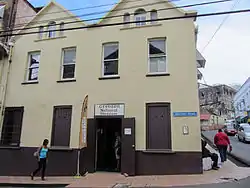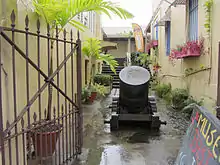Grenada National Museum
The Grenada National Museum is a museum in St. George's, Grenada. It is housed in a building which served as the French barracks from 1704, built on the foundations of the Fort George. It was used as a prison by the British for female inmates until 1880. It later became two different hotels under different owners and at one point was used as a warehouse by a merchant working in St. George's. The museum was established in 1976 on the theme of archaeology and history. Museum sections include "Slavery, First Inhabitants, Plantation Economy, Whaling & Fishing Archaeology, and Early Transport & Technology". The museum displays a variety of historical items including Carib and Arawak artifacts, sugar processing machines and equipment, whaling industry items, and Josephine Bonaparte's marble bath.
 | |
 Grenada National Museum | |
| Established | 1976 |
|---|---|
| Location | Monckton Street, St. George's, Grenada |
| Coordinates | 12.050576°N 61.752655°W |
| Type | Amerindian and European History and heritage |
| Website | www |
History
The museum is housed in a building located at the corner of Young and Monckton streets. It served as a military barracks for the French army in 1704. It was used as prison by the British for female inmates until 1880.[1] It then became the island's first hotel.[2][3] Two other different hotels under different owners followed, and at one point was used as a warehouse by a merchant working in St. George's.[1]

The museum was established in 1976 by private citizens who organized as the country's historical society.[4] The theme is archaeology and history.[5] With donations received from the Republic Bank, the museum is slated to improve the quality of exhibits related to Armanadian culture and history and of the invasions.[6]
Collections and displays
Museum sections include "Slavery, First Inhabitants, Plantation Economy, Whaling & Fishing Archaeology, and Early Transport & Technology".[1] The native Grenadian culture is well represented.[2] The exhibits in the museum cover history from the Ciboneys (native Indian culture of Grenada[7]) to the colonial period.[8]
Displays consist of remnants of pottery finds of the Amerindians, an ancient rum still, and the marble bathtub used by Empress Josephine when she was a child.[9] There are exhibits of events related to the assassination of Maurice Bishop and the war that resulted as a result of storming of Grenada by the US.[3] Apart from cultural history the exhibits also cover political events till the 1980s.[10] Though small, there are exhibits of antiquaries from the archaeological excavations, including ceramics, plus petroglyphs of native fauna, and the first telegraph line installed in the city in 1871.[2][7] Also of note are Kalinago, Yoruba,[4] and Arawak artifacts, sugar processing machines and equipment, and whaling industry items.[1] Proclamations, photos, and news items chronicle events such as the Invasion of Grenada.[9] Exhibits are also provided by children from local schools.[4]
Education
An education programme under the title “The Grenada National Museum Press” (GNMP) has been established to provide information to the visitors on the history of the Caribs Island, the thwarted attempt of the British in 1609 to settle on the island, and the period of French occupation.[11] The Grenada Historical Society is also located within the museum.[5] Educational books, maps, and pamphlets are available,[8] as well as educator resources to accommodate group visits to the museum.[12]
References
- "Grenada National Museum". Grenadagrenadines.com. Retrieved 11 July 2013.
- Colón, Christina Paulette; Flippin, Alexis Lipsitz; Marino, John; Porter, Darwin; Prince, Danforth (22 July 2011). Frommer's Caribbean. John Wiley & Sons. p. 774. ISBN 978-1-118-10734-8.
- "Grenada National Museum". Lonely Planet. Retrieved 12 July 2013.
- Crask, Paul (July 2012). Bradt Grenada: Carriacou, Petite Martinique. Bradt. p. 102. ISBN 978-1-84162-401-3.
- "Grenada:Culture". Encyclopædia Britannica. Retrieved 12 July 2013.
- "Grenada National Museum Receives Major Donation from Republic Bank". Now Grenada.com. Retrieved 12 July 2013.
- Huber, Joyce (15 April 2011). Best Dives of Grenada, St. Vincent and the Grenadines. Hunter Publishing, Inc. p. 12. ISBN 978-1-58843-763-1.
- Showker, Kay (1 March 2006). Eastern and Southern Regions: A Guide for Today's Cruise Passengers. Globe Pequot Press. p. 267. ISBN 978-0-7627-3885-4.
- Fodor's (28 December 2010). Fodor's Barbados, St. Lucia, St. Vincent, the Grenadines & Grenada. Fodor's Travel Publications. p. 206. ISBN 978-0-307-92803-0.
- "Exploring Grenada". Geographia.com. Retrieved 12 July 2013.
- "Grenada National Museum To Host The First Major History Of The French In Grenada". ARC Magazine. Retrieved 12 July 2013.
- Grenada National Museum, "Educator Resources" Archived 27 October 2014 at the Wayback Machine, Grenada National Museum, 2013.